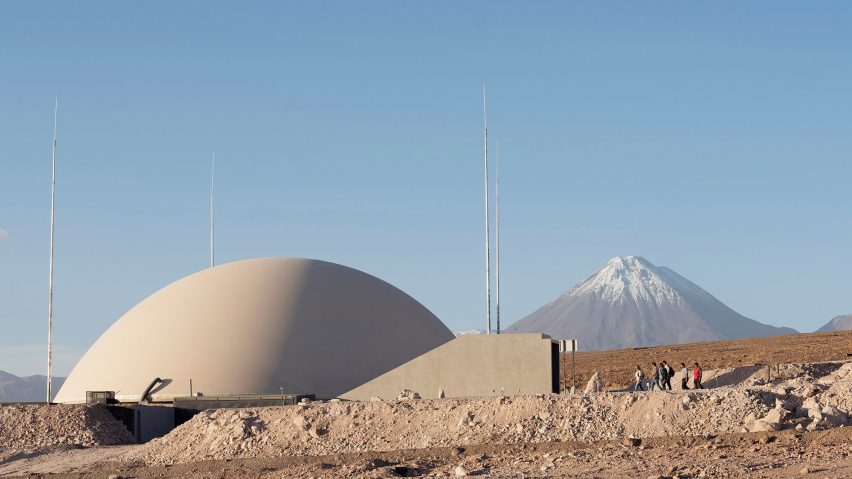Local architecture studio Benjamín Murúa Arquitectos has topped an underground sports centre with a dome in the Atacama desert in Chile.
The sports facility is located on the campus of the Atacama Large Millimeter/submillimeter Array (ALMA) Observatory, a research complex dedicated to the study of deep space.
For the design of the complex, the studio was largely informed by the harsh climate of the site. Bordered by the Andes mountains, the region is home to high winds and dust storms, snow, high radiation and fluctuating desert temperatures.
To accommodate the varied weather, the studio created an aerodynamic dome that covers an oval-shaped sports court and adjoining facilities below.
The curving roof is made of a double membrane made of PVC and carbon fibre filaments. The slightly translucent material protects the interior from solar radiation while illuminating the space with the help of electric light.
Trusses of glued-laminated timber (glulam) support the required curve of the structure while also creating gaps for light to enter. The wooden structure and roof membrane create a flexible cap that is also durable in the face of the region's weather.
Underneath the dome, the sports complex comprises 965 square metres, at 4.5 metres below grade. The facility contains an indoor basketball, soccer, and volleyball court; as well as changing rooms, a gym and restrooms.
The oval shape of the space conforms to the curved roof and is made of concrete. Its underground position allows for the use of geothermal energy and additionally protects the space from the elements above.
The facility's design reduces the need for mechanical cooling and heating.
"The temperature remains stable at 16-18 degrees Celsius," said studio founder Benjamín Murúa. "The energy consumption is practically zero."
Towards the shorter curved end of the central court, a small gym space branches off and features floor-to-ceiling windows that look into the court.
A hallway at the same end leads to additional amenities like changing rooms, restrooms and the utility room.
The entrance to the sports complex is a concrete structure that lies adjacent to the domed roof at ground level. Inside the structure, a sloping pathway leads downwards to the network of facilities. An elevator can also be used to access the space.
The sports facility is located on the residential campus of the ALMA Observatory, which is home to the largest radio telescope in the world. The facility will serve the employees who live on the observatory's campus to improve living conditions.
Other sports facility design includes the Obama Sports Complex in Los Angeles by SPF Architects and an outdoor sports pavilion by Quintanilla Arquitectos in Mexico.
The photography is by Cristóbal Correa.

